
Hands-On MQTT Programming with Python
Work with the lightweight IoT protocol in Python
Gaston C. Hillar
- 228 pagine
- English
- ePUB (disponibile sull'app)
- Disponibile su iOS e Android
Hands-On MQTT Programming with Python
Work with the lightweight IoT protocol in Python
Gaston C. Hillar
Informazioni sul libro
Explore the features included in the latest versions of MQTT for IoT and M2M communications and use them with modern Python 3.
Key Features
- Make your connected devices less prone to attackers by understanding security mechanisms
- Take advantage of MQTT features for IoT and Machine-to-Machine communications
- The only book that covers MQTT with a single language, Python
Book Description
MQTT is a lightweight messaging protocol for small sensors and mobile devices. This book explores the features of the latest versions of MQTT for IoT and M2M communications, how to use them with Python 3, and allow you to interact with sensors and actuators using Python.
The book begins with the specific vocabulary of MQTT and its working modes, followed by installing a Mosquitto MQTT broker. You will use different utilities and diagrams to understand the most important concepts related to MQTT. You will learn tomake all the necessary configuration to work with digital certificates for encrypting all data sent between the MQTT clients and the server. You will also work with the different Quality of Service levels and later analyze and compare their overheads.
You will write Python 3.x code to control a vehicle with MQTT messages delivered through encrypted connections (TLS 1.2), and learn how leverage your knowledge of the MQTT protocol to build a solution based on requirements. Towards the end, you will write Python code to use the PubNub cloud-based real-time MQTT provider to monitor a surfing competition.
In the end, you will have a solution that was built from scratch by analyzing the requirements and then write Python code that will run on water-proof IoT boards connected to multiple sensors in surfboards.
What you will learn
- Learn how MQTT and its lightweight messaging system work
- Understand the MQTT puzzle: clients, servers (formerly known as brokers), and connections
- Explore the features included in the latest versions of MQTT for IoT and M2M communications
- Publish and receive MQTT messages with Python
- Learn the difference between blocking and threaded network loops
- Take advantage of the last will and testament feature
- Work with cloud-based MQTT interfaces in Python
Who this book is for
This book is for developers who want to learn about the MQTT protocol for their IoT projects. Prior knowledge of working with IoT and Python will be helpful.
Domande frequenti
Informazioni
Installing an MQTT 3.1.1 Mosquitto Server
- Understanding convenient scenarios for the MQTT protocol
- Working with the publish-subscribe pattern
- Working with message filtering
- Understanding the MQTT puzzle: clients, servers, and connections
- Installing a Mosquitto server on Linux
- Installing a Mosquitto server on macOS
- Installing a Mosquitto server on Windows
- Considerations for running a Mosquitto server in the cloud
Understanding convenient scenarios for the MQTT protocol
- Raspberry Pi 3 Model B+
- Qualcomm DragonBoard 410c
- Udoo Neo
- BeagleBone Black
- Phytec phyBoard-i.MX7-Zeta
- e-con Systems eSOMiMX6-micro
- MinnowBoard Turbot Quad-Core

- Asset tracking and management
- Automotive telematics
- Chemical detection
- Environment and traffic monitoring
- Field force automation
- Fire and gas testing
- Home automation
- In-Vehicle Infotainment (IVI)
- Medical
- Messaging
- Point of Sale (POS) kiosks
- Railway
- Radio-Frequency Identification (RFID)
- Supervisory Control and Data Acquisition (SCADA)
- Slot machines
- Be lightweight to make it possible to transmit high volumes of data without huge overheads
- Distribute minimal packets of data in huge volumes
- Support an event-oriented paradigm with the asynchronous, bidirectional, low-latency push delivery of messages
- Easily emit data from one client to many clients
- Make it possible to listen for events whenever they happen (event-oriented architecture)
- Support always-connected and sometimes-connected models
- Publish information over unreliable networks and provide reliable deliveries over fragile connections
- Work very well with battery-powered devices or require low power consumption
- Provide responsiveness to make it possible to achieve near-real-time delivery of information
- Offer security and privacy for all the data
- Be able to provide the necessary scalability to distribute data to hundreds of thousands of clients
Working with the publish-subscribe pattern
